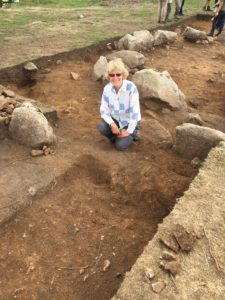Jane Cable leaves the comfort of her desk
Authors do many things in the name of research and some of them are definitely more fun than others. To be honest, most research these days is carried out hunched over a laptop, flicking from website to website, desperately trying not to be side-tracked. How historical novelists manage it I’ll never know, but I take my hat off to them.
The manuscript I’ve been struggling over for what feels like (and may even be) years has an archaeologist as its heroine. At the moment it’s undergoing a major, major rewrite – which started after a research visit to an antiques centre at a former RAF base – and Rachel’s job is actually less important, but I still wanted to know how it felt to be working in a trench.
Step in DigVentures. For those who don’t know it’s a social enterprise that designs and delivers collaborative archaeology projects using community involvement, crowd funding and digital technology to enable public participation at every level. Including with a trowel. Which is mighty unusual as volunteers at many other digs are restricted to moving barrow-loads of earth or washing finds.
My husband’s always been interested in archaeology so when the call went out on Facebook for volunteers for a dig on the edge of Bodmin Moor we signed up with alacrity. Just as well we did, because there were very few places available. With mounting excitement we read the brief about a Bronze Age/Iron Age settlement, bought ourselves lightweight gardening gloves and packed enough picnic food to last a week.
 Our fellow diggers and the professional archaeologists were a friendly lot, and most of them had already been at St Neot for almost two weeks. We were coming in right at the end of things, so after a briefing we were taken to a trench and set to work cleaning a small section. Looking back this could have been a test just to make sure we weren’t too cack-handed – a real possibility in my case – then we were moved to our very own area.
Our fellow diggers and the professional archaeologists were a friendly lot, and most of them had already been at St Neot for almost two weeks. We were coming in right at the end of things, so after a briefing we were taken to a trench and set to work cleaning a small section. Looking back this could have been a test just to make sure we weren’t too cack-handed – a real possibility in my case – then we were moved to our very own area.
This was exciting. Under the watchful eye of trench supervisor Indie and constant visits from Bronze Age specialist Ed we were to scrape through an unusual hard, grey deposit and collect it in bags to be sampled. Indie explained that back in the lab it would be separated and tested in the hope that particles of vegetation or valuable dating evidence would be found.
The area we were digging was part of the bank surrounding the settlement and had a large ditch on the outer side. Behind us in the main trench were the clear remains of a roundhouse, marked out by stones. The earth there was a completely different colour – the orangey-brown ‘natural’ that we would need to scrape down to find. We filled our three bags and the charcoal we kept coming across took me back to my mother taking the ashes from the fire out and spreading them on the garden. It gave me goosebumps that people could have been doing the very same thing for thousands of years.
I learnt a great deal about archaeology. As Ed told us, we went straight from level one to level five in one fell swoop. But what did I learn of value for my book? Tiny things, but important things. How the rain soaks through your gloves and your fingers chafe. Which parts of your body ache the most. The dust that fills your nose and coats your hair. So many things that will help to make Rachel real.
As I shared the experience on social media many friends expressed envious interest, but really, DigVentures makes it possible for anyone to join in. We’ll certainly be back again. And again. And again.
Find out more about DigVentures and St Neot here: https://digventures.com/st-neot/


Hi Angela… I’m not sure we’ll be going as far as lining our house with skulls… Glad you enjoyed the article!
What a fascinating experience! A very good friend of ours was an archeologist in Cornwall for many years and used to have skulls he’d dug up lining the stairs in his old house.